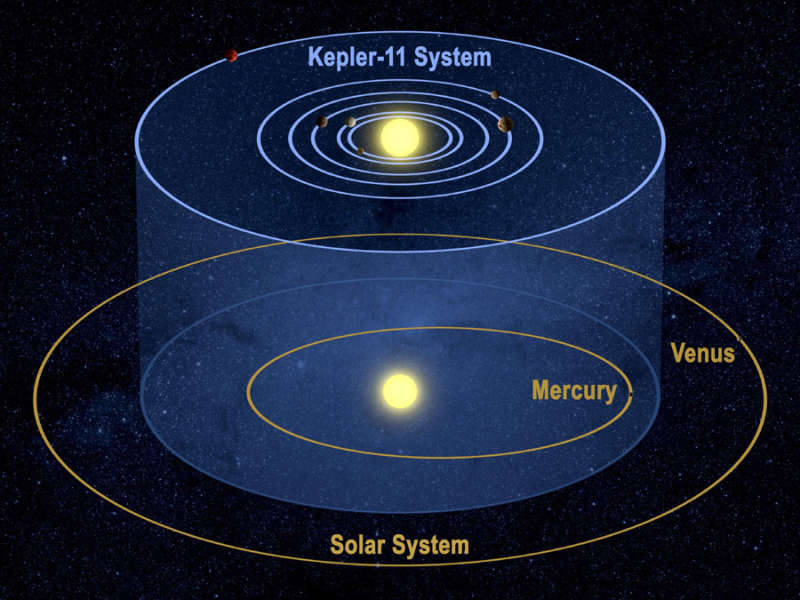
|
Credit & Copyright: Tim Pyle, NASA
Explanation:
Six worlds orbit Kepler-11,
a sunlike star 2,000 light-years
distant in the constellation Cygnus.
The new discovery, based on data from NASA's
planet hunting Kepler spacecraft,
makes the Kepler-11 system
the fullest exoplanetary system known.
Compared to our Solar System in this illustration,
five of Kepler-11's planets orbit closer to their parent star than the
Mercury-Sun distance, with
orbital periods ranging from 10 to 47 days.
All six are larger than Earth and are likely composed of mixtures of
rocky material and gas.
Their presence, sizes, and masses have been determined by carefully
watching the planets dim the light of Kepler-11 while
transiting or
crossing in front of the star itself.
In fact, in August 2010, Kepler's telescope and camera
recorded a simultaneous transit of three of the planets in the system.
As announced yesterday,
using the transit technique
the Kepler mission has now identified over
1200 exoplanet candidates in a
field of view
that covers only about 1/400th of the sky.
The tantalizing result suggests there are many
undiscovered
planets orbiting the stars in
our galaxy.
|
January February March April May June July August September October November December |
| ||||||||||||||||||||||||||||||||||||||||||||||||
NASA Web Site Statements, Warnings, and Disclaimers
NASA Official: Jay Norris. Specific rights apply.
A service of: LHEA at NASA / GSFC
& Michigan Tech. U.
Based on Astronomy Picture
Of the Day
Publications with keywords: extrasolar planet - kepler - transit
Publications with words: extrasolar planet - kepler - transit
See also:
- APOD: 2025 September 8 Á IRAS 04302: Butterfly Disk Planet Formation
- APOD: 2025 March 16 Á Venus and the Triply Ultraviolet Sun
- APOD: 2024 July 8 Á Exoplanet Zoo: Other Stars
- Temperatures on Exoplanet WASP 43b
- Epsilon Tauri: Star with Planet
- APOD: 2023 October 17 Á PDS 70: Disk, Planets, and Moons
- APOD: 2023 September 20 Á Methane Discovered on Distant Exoplanet
